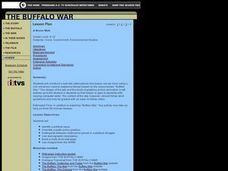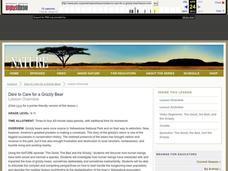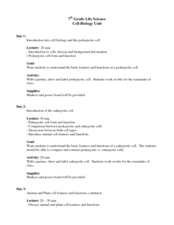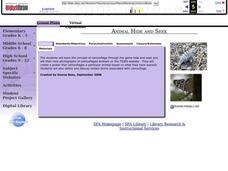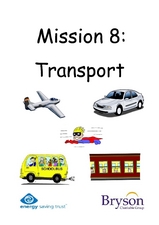Curated OER
The Impacts of Human Activities on Biodiversity in New Haven County
Students discover how plants and animal ecosystems are affected by the growth of a city. In this ecology lesson, students study and observe a plant over a period of time. They develop a creative presentation of their data and share them...
Curated OER
The Water Cycle
Students create terrariums in containers in order to study the Water Cycle. They examine how the terrarium maintains life in the closed environment.
Curated OER
Woodland Animals and Their Habitat
Learners explore the natural environment through a video and nature sounds tape. They keep journal's of the unit's activities and vocabulary terms. They play a web of interdependence game and compose a list of forest animals and write...
Curated OER
A Bison Web
High schoolers view a documentary on the treatment of the buffalo. In groups, they create a website using ideas and solutions they developed. They must include graphics or animation and a multi-level webpage. They share their pages...
Curated OER
Issues And Decisions 4
For this environment worksheet, students read a passage on why alien species should be introduced to ecosystems. Then they respond to four questions that refer to the passage read. Students also respond to two decision questions by...
Curated OER
Cell Parts
In this biology worksheet, students read about the parts of both plant and animal cells and examine cell diagrams. They read about the function of cell parts before answering 11 online fill in the blank questions.
Curated OER
Habitat Art: Florida Panthers
Students discover the lifestyles of a Florida Panther by investigating its habitat. In this wild animal instructional activity, students utilize the Internet to research the habits of a Panther and what their habitat is. Students...
Curated OER
Plants and Animals
Students find common needs between plants and animals. In this plants and animals lesson students compare that both plants and animals need food and water. They also find the differences between plant and animal needs.
Curated OER
Nocturnal vs. Diurnal Animals
First graders identify nocturnal and diurnal animals. In this animal activity, 1st graders discuss the differences between animals that are active during the day and those that are active at night. Students write summaries about their...
Curated OER
Food Webs and Making Miniature Ecosystems
Students model a food web and create a miniature ecosystem. In this animal interactions lesson, students engage in a role playing game which simulates a food web. Students then build miniature ecosystems using pop bottles, snails, plants...
Curated OER
Dare to Care for a Grizzly Bear
Young scholars examine the relationship between humans and grizzly bears. In this biology lesson, students research about the bear's habits and living environment. They write a letter to the US Fish and Wildlife Service petitioning them...
Curated OER
The Desert Alphabet Book
Learners explore world geography by researching a science book with their classmates. In this desert identification lesson, students utilize a U.S. map to locate the geographical locations of deserts. Learners create an oral report based...
Curated OER
Cell (Biology)
Students conduct a series of activities to explore the nature of cells. In this biology lesson, students observe plant and animal cells under the microscope and compare them. They differentiate osmosis and diffusion.
Curated OER
Flora and Fauna of the Hill Neighborhood
Students compare and contrast the characteristics of plants and animals. In this ecology activity, students observe the outdoors and describe the relationship among different living things. They relate plant diversity with animal diversity.
Curated OER
Fact Finding Safari
In this fact finding worksheet, students read 10 questions, all pertaining to animals or the environment. Students write the answers to the questions, using Internet research if necessary.
Curated OER
TIDES
Second graders are taught the concept of camouflage through the game hide and seek. They view photographs of camouflaged animals on the TIDES website. Students create a poster that camouflages a particular animal based on what they have...
Curated OER
Plants
Sixth graders examine how plants collect water and breathe. In groups, they participate in a variety of activities in which they discover how plants operate in terrariums. To end the lesson, they discuss why plants are important to the...
Curated OER
Lessons From the Lorax
Pupils read and discuss Dr. Seuss's The Lorax. They explore the changes the characters could have made to preserve the environment and relate the plot to real-world places and events.
Curated OER
Mission 8: Transport
In these transportation worksheets, students learn about the various modes of transportation, the energy they use, and ways transportation affects the environment. Students complete a 15 page packet for the activity.
Curated OER
How Do Adaptations Help Living Things?
In this adaptations worksheet, students will brainstorm a problem that a living thing might face in its environment. Then students will write down what solution or adaptation that living thing has that allows it to survive that...
Sea World
Ocean Discovery
Immerse your young marine biologists in the world of marine animals. The lesson includes several activities that are age-appropriate for preschoolers and kindergartners, including coloring pages, gluing feathers and sand onto paper...
Mobile Education Store
SentenceBuilderTeen™
Have you seen a large number of grammatically incorrect sentences in class writing lately? Help alleviate that issue with this app, which is targeted toward teenagers. Class members look at age-appropriate images and choose the correct...
beyondblue
Me, Myself, I: Self-Concept and Self-Esteem
Celebrate the positive qualities of young learners with this collection of self-esteem worksheets. After first listing their interests and personal qualities, students go on to monitor their self-esteem over the course of a week,...
Charleston School District
Parallel Lines Cut by a Transversal
Pupils study angle measurements between different types of angles associated with parallel lines and transversals. The independent practice asks pupils to identify the types of angles in a diagram and to determine the measure of angles.





